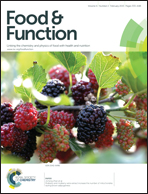The colorants, antioxidants, and toxicants from nonenzymatic browning reactions and the impacts of dietary polyphenols on their thermal formation
Abstract
Nonenzymatic browning reactions proceed with the starting reactants of sugar and/or protein during thermal processing and storage of food. In addition to food color formation, the process also contributes to the loss of essential nutrients, generation of beneficial antioxidants, and production of toxicants, including 5-hydroxymethylfurfural (5-HMF), reactive carbonyl species, advanced glycation end products (AGEs), and heterocyclic amines (HAs). Recent research has demonstrated that dietary polyphenols can actively participate in nonenzymatic browning reactions, contributing to the generation of new colorants and antioxidants. More importantly, polyphenol addition has been found to be an effective approach to mitigate heat-induced formation of toxicants, mainly through inhibiting oxidative pathways and trapping reactive intermediates. In the matrix of polyphenol-fortified foods, a complex array of chemical interactions happen among polyphenols, traditional nutritional components, and neo-formed compounds they are thermally converted to. These reactions play a significant role in the colorants, antioxidants as well as toxicants production. Our findings support the potential of dietary polyphenols for increasing the antioxidant content and for reducing the level of toxicants when they participate in nonenzymatic browning reactions in fortified food products.


 Please wait while we load your content...
Please wait while we load your content...